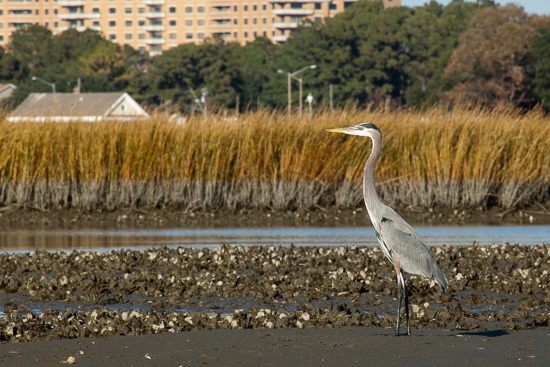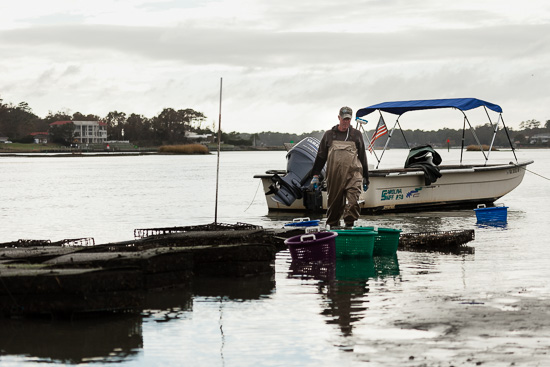‘Hand-crafting’ oysters in the Lynnhaven River
Pleasure House Oysters benefit from small-scale, local approach to oyster farming
Oysters from Virginia’s Lynnhaven River were once world-renowned. In the 1800s, U.S. presidents and European royalty alike dined on briny bivalves sourced from the Lynnhaven, and rumor holds they were served aboard the Titanic.
While the humble Eastern oyster (Crassostrea virginica) can be found all along the East Coast, the unique combination of water temperature and salinity found in the Lynnhaven—located just miles from where the Chesapeake Bay meets the Atlantic—made its flavor exceptional.
But fame couldn’t keep the Lynnhaven oyster safe from decline. Over the years, harvest pressure, loss of habitat and water pollution converged to decimate oyster populations in the waterway: by 1990, oysters in the Lynnhaven were at one percent of their historic levels. In particular, bacteria entering the river from human and animal waste led many parts of the river to be closed to oyster harvesting for decades. In 2006, the entire Lynnhaven was condemned for shellfish harvesting because of high bacteria levels.
Today, however, the story of the Lynnhaven oyster is one of hope. Spurred to action after watching their river suffer decades of decline, local groups like Lynnhaven River NOW worked—and continue to work—to restore the waterway. Bacteria levels have been reduced, thanks to the help of a Total Maximum Daily Load (TMDL) implemented for bacteria in the river’s shellfish areas and the designation of the region as a No Discharge Zone, meaning boaters are banned from discharging holding tanks into the river.
As of earlier this year, 42 percent of the Lynnhaven had been reopened to oyster harvesting—encouraging news for oyster farmers like Captain Chris Ludford of Ludford Brothers Oyster Company, home of the Pleasure House Oyster.
“People lost confidence in eating oysters,” Ludford says. “Now, we’re reaping the rewards of cleaner water… people are more confident in the oysters and more confident in the things they’re eating.”
In the world of oyster aquaculture, Ludford is somewhat of an artisan. Each oyster is “hand-crafted” by Ludford and a team of his family and friends, who complete nearly all the work by hand: selecting, tumbling, grading, cleaning, counting and packaging the oysters for sale to nearby restaurants. The only machinery involved is the boat he uses to reach the oysters, and even that he hopes to switch to an electric motor in the next few years.

Ludford has been actively growing oysters on the Lynnhaven since 2010. He currently manages close to 60 acres of both farmed and wild oysters—including a wild reef he’s working to rebuild—all while continuing his job as a fireboat captain for the Virginia Beach Fire Department. He also offers tours of his farms and allows researchers from Virginia Institute of Marine Science, Christopher Newport University and other institutions to study his oysters.
Business is steady, with Pleasure House Oysters on the menu at seven top restaurants in Virginia Beach and Norfolk, but Ludford is committed to keeping his operation small. For him, three groups benefit from his local, small-scale approach: the first two being his family and his customers.
“We built a business on a hand-crafted oyster. Staying small and staying local allows us to do that,” Ludford explains. “Our customers, mainly restaurants and the people who patronize those restaurants, they come there for our oysters. They know my family puts a lot of love—about two years of love—into each oyster.”
The third beneficiary of Ludford’s hand-crafted approach “can’t really speak for themselves, and that’s the environment,” Ludford says. “The river itself likes to see a small operation, I believe, because we have a small footprint on the environment.” His work to rebuild wild oyster reefs also provides habitat to other river residents, including oyster toadfish, gobies, blue crabs, sea bass, periwinkles and countless other species.

In recent years, Ludford has watched what he calls an “oyster revolution” take hold. In the past, pollution made even those who had grown up eating oysters wary of consuming them. These days, not only are veteran ostreophiles—or oyster lovers—returning to the scene, but a new generation of oyster-eaters has emerged. Ludford sees it as a way to remind people that what they’re eating is a measure of the Lynnhaven’s health.
“Oysters are the canary in the coal mine,” Ludford says. “If the water is clean enough to eat the oysters from, then it’s a great compliment for the people who live and play and recreate on that water.”
Not only are healthy oysters a sign of a healthy waterway, the bivalves also help to clean the water even further. As filter feeders, oysters feed by pumping water through their gills, trapping particles of pollution in the process. In a single day, one oyster can filter more than 50 gallons of water. Multiplied by thousands of oyster cages, each holding hundreds of oysters, the result is a water-filtering powerhouse.
“When [people] see an oyster farmer or an oysterman behind their house, they should be happy that they’re there,” Ludford says. “We’re contributing to cleaning the water even further, and it’s a great indicator of how clean that water is.”
To see more photos, visit the Chesapeake Bay Program’s Flickr page.

Comments
There are no comments.
Thank you!
Your comment has been received. Before it can be published, the comment will be reviewed by our team to ensure it adheres with our rules of engagement.
Back to recent stories